tires AUDI A5 COUPE 2014 Owners Manual
[x] Cancel search | Manufacturer: AUDI, Model Year: 2014, Model line: A5 COUPE, Model: AUDI A5 COUPE 2014Pages: 286, PDF Size: 70.99 MB
Page 5 of 286
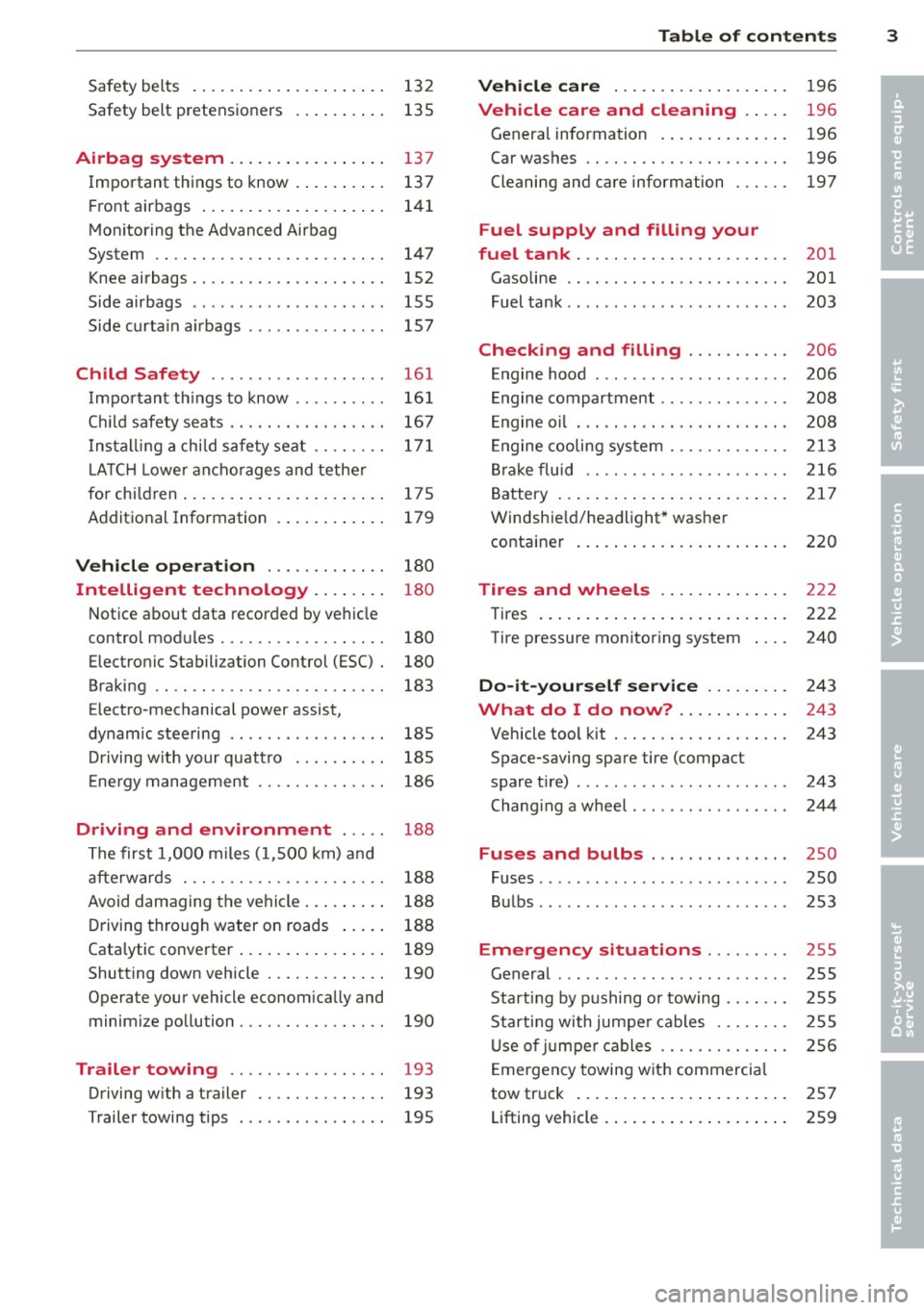
Safety belts . . . . . . . . . . . . . . . . . . . . . 132
Safety belt pretens ioners . . . . . . . . . . 135
Airbag system .. .... ... .. .. .. .. 137
I mportant th ings to know . . . . . . . . . . 137
Fr ont airbags . . . . . . . . . . . . . . . . . . . . 141
Mon itor ing the Advanced Airbag
System . . . . . . . . . . . . . . . . . . . . . . . . . 147
Knee airbags . . . . . . . . . . . . . . . . . . . . . 152
Side airbags . . . . . . . . . . . . . . . . . . . . . 155
Side curta in a irbags . . . . . . . . . . . . . . . 157
Ch ild Safety ........ .... ... ... .
Important things to know ....... .. .
C hil d safety s eats .... ... .. .. .. .. . .
I n st all ing a chi ld safe ty seat .. .. .. . .
L A TC H Lowe r ancho rages and tethe r
for ch ild ren ..... ...... ... .. .. .. . .
A ddit ional Information 161
16
1
167
17 1
175
179
Vehicle operation . . . . . . . . . . . . . 180
Intelligent technology . . . . . . . . 180
N ot ice about data recorded by veh icle
contro l mod ules . . . . . . . . . . . . . . . . . . 180
Electronic Stabili zation Control (ESC) . 180
Braking . . . . . . . . . . . . . . . . . . . . . . . . . 183
Elect ro -mechanical power assist,
dynam ic stee ring . . . . . . . . . . . . . . . . . 185
Dr iving w ith your quattro . . . . . . . . . . 185
E ne rgy management . . . . . . . . . . . . . . 186
Driving and environment . . . . . 188
T he first 1, 000 miles (1, 500 km) a nd
afterw ards . . . . . . . . . . . . . . . . . . . . . . 18 8
Avoid damaging the vehi cle . . . . . . . . . 188
D riving through water on roads . . . . . 188
Cata lytic converter . . . . . . . . . . . . . . . . 189
Shutting down vehicle . . . . . . . . . . . . . 190
Operate your vehicle econom ica lly and
minim ize po lluti on . . . . . . . . . . . . . . . . 190
Trailer towing . . . . . . . . . . . . . . . . . 193
Driving w ith a tra iler . . . . . . . . . . . . . . 193
T railer towing tips . . . . . . . . . . . . . . . . 195
Table of contents 3
Vehicle care . . . . . . . . . . . . . . . . . . .
196
Vehicle care and cleaning . . . . . 196
Genera l information . . . . . . . . . . . . . . 196
Car washes . . . . . . . . . . . . . . . . . . . . . . 196
Cleaning and care information . . . . . . 197
Fuel supply and filling your
fuel tank . . . . . . . . . . . . . . . . . . . . . . .
201
Gasoline . . . . . . . . . . . . . . . . . . . . . . . . 201
Fuel tank . . . . . . . . . . . . . . . . . . . . . . . . 203
Checking and filling . . . . . . . . . . . 206
E n gine hood . . . . . . . . . . . . . . . . . . . . . 206
E ngine compartment . . . . . . . . . . . . . . 208
E ngine o il . . . . . . . . . . . . . . . . . . . . . . . 20 8
En gine cooling sy stem . . . . . . . . . . . . . 213
Br ake fluid . . . . . . . . . . . . . . . . . . . . . . 216
B attery . . . . . . . . . . . . . . . . . . . . . . . . . 217
Windshie ld/headlight* was her
containe r . . . . . . . . . . . . . . . . . . . . . . . 220
Tires and wheels . . . . . . . . . . . . . . 222
Tires . . . . . . . . . . . . . . . . . . . . . . . . . . . 222
Tire pressure monitor ing system 240
Do-it-yourself service . . . . . . . . . 243
What do I do now? . . . . . . . . . . . . 243
Vehicle tool kit . . . . . . . . . . . . . . . . . . . 243
Space-saving spare tire (compact
spare t ire) . . . . . . . . . . . . . . . . . . . . . . . 243
Chang ing a wheel . . . . . . . . . . . . . . . . . 244
Fuses and bulbs . . . . . . . . . . . . . . . 250
Fuses ... .. .. .. .. .. . .. .... .... .. . 250
B ul bs. . . . . . . . . . . . . . . . . . . . . . . . . . . 253
Emergency situations . . . . . . . . . 255
Genera l . . . . . . . . . . . . . . . . . . . . . . . . . 255
Start ing by pushing or towing . . . . . . . 255
Star ting with jumpe r cables . . . . . . . . 255
U se o f jumpe r ca bles . . . . . . . . . . . . . . 256
E mergency towing wit h commerci al
tow truck . . . . . . . . . . . . . . . . . . . . . . . 257
Lifting vehicle . . . . . . . . . . . . . . . . . . . . 259
•
•
Page 33 of 286
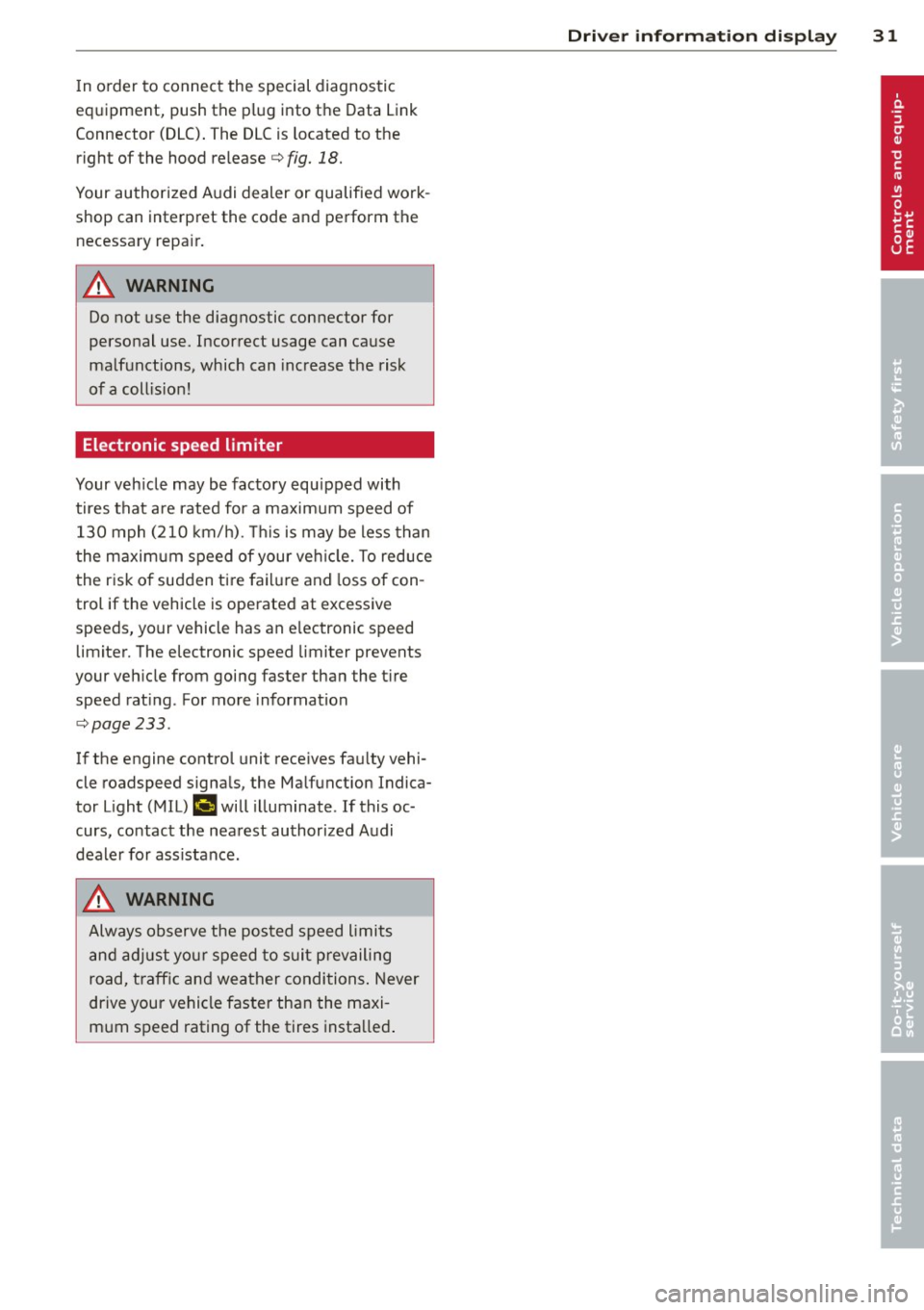
In o rder to connect the special diagnostic
equipment, push the plug into the Data Link
Connector (DLC) . The DLC is located to the
right of the hood release ¢
fig. 18.
Your authorized A udi dealer or qualified work
shop can interpret the code and perform the necessary repa ir.
A WARNING
Do not use the diagnostic connector for
personal use. Incorrect usage can cause
malfunctions, which can increase the risk
of a coll is ion!
Electronic speed limiter
-
Your veh icle may be factory equipped with
tires that are rated for a maximum speed of 130 mph (210 km/ h). Thi s is may be less than
the maximum speed of your ve hicle. To red uce
the risk of sudden ti re failure and loss of con
trol if the vehicle is operated at excessive
speeds, your vehicle has an e lectronic speed
limiter. The electronic speed limiter prevents
your veh icle from going faster than the t ire
speed rat ing . For more informat ion
¢ page 233 .
If the engine control unit rece ives fa ulty vehi
cle roadspeed signa ls, the Ma lfunction Indica
tor Light (MIL)
¢4 will illuminate . If this oc
curs, contact the nearest authorized Audi
deale r for assistance.
A WARNING
-
Always observe the posted speed limits
and ad just yo ur speed to suit p revail ing
road, traff ic and weather conditions . Never
drive your vehicle faster than the maxi
mum speed rating of the tires insta lled .
Dri ver information di spla y 31
Page 81 of 286
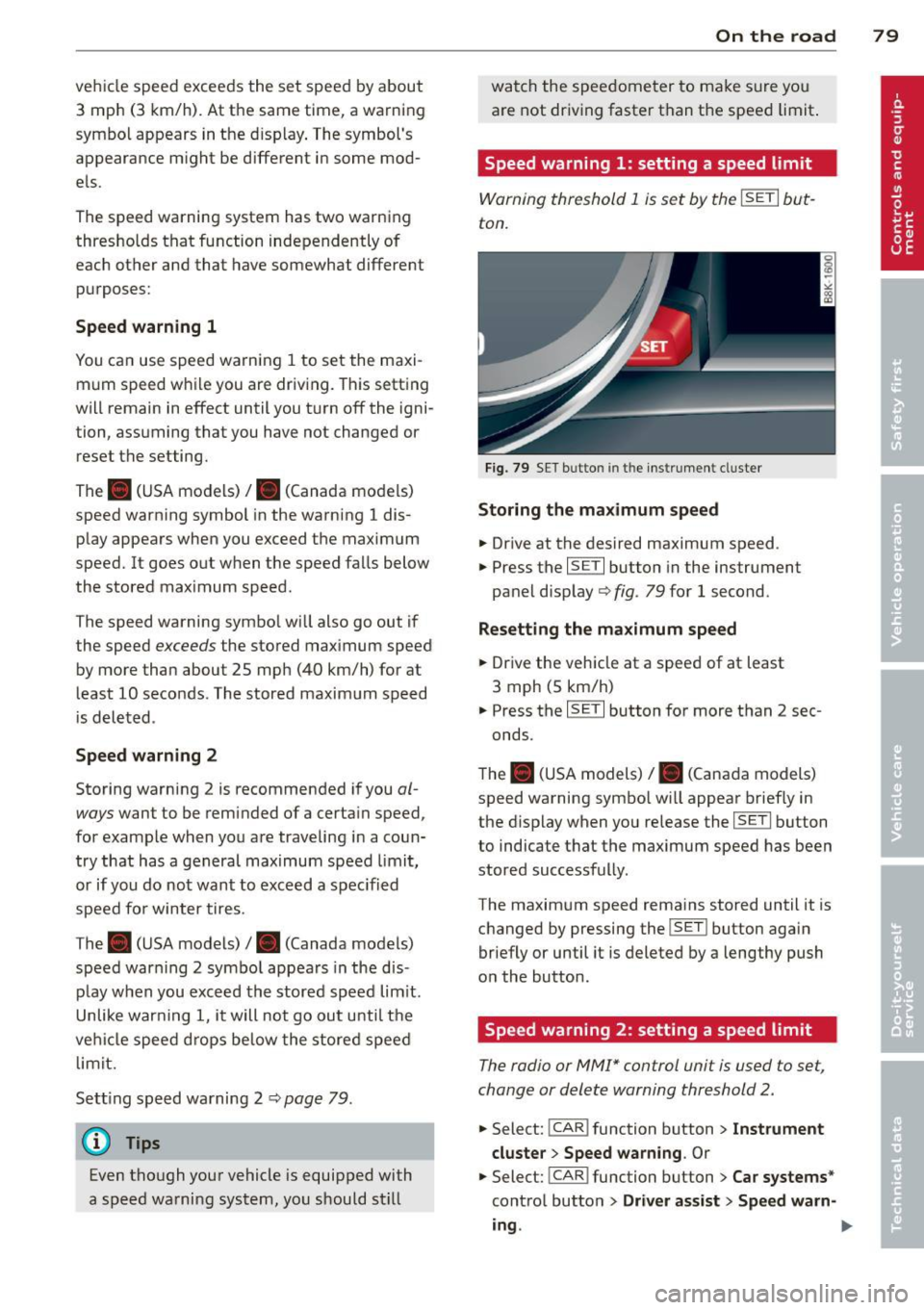
vehicle speed excee ds the set speed by about
3 mph (3 km/h). At the same time, a wa rning
symbo l appears in the d isp lay . The symbol's
appearance might be different in some mod
e ls.
The speed warning system has two warning thresholds that function independently of
each other and that have somewhat different
pu rposes:
Speed warning 1
You ca n use speed warnin g 1 to set the maxi
mum s peed w hile you are driv ing. Th is sett ing
will remain in effect until you t urn off the igni
tion, assuming that you have not changed or reset the setting.
The . (USA mo dels) /. (Canada mo dels)
speed warning symbol in the warning 1 dis
p lay appears when you exceed t he maximum
speed. It goes o ut w hen t he speed fa lls below
the s tored max imum speed.
T he speed warning symbo l wi ll also go out i f
the speed
exceeds the stored maximum speed
by more than about 25 mph (40 km/h) for at
least 10 seconds. The stored maxim um speed
i s deleted .
Speed warning 2
Storing warn ing 2 is recommended if you al
ways
want to be reminded of a certa in speed ,
for example when you a re traveling in a coun
try that has a general maximum speed limi t,
or if you do not want to exceed a spec if ied
speed fo r winter tires.
The . (USA models) /. (Canada models)
speed war ning 2 symbo l appears in the d is
p lay w hen you exceed the stored spee d lim it.
Unlike war nin g 1, it will not go out u nti l th e
ve hicl e spee d drops be low the store d spee d
li m it.
Set ting s peed wa rning 2
r::;, page 79 .
@ Tips
Even t hough you r vehicle is equipped with
a speed warning system, yo u should st ill
On the road 79
watch the spee dome ter to ma ke sur e yo u
are not dr iv ing faste r th an the speed limit .
Speed warning 1: setting a speed limit
Warning threshold 1 is set by the !SE TI bu t
ton.
Fig . 79 SE T button in the instr um ent cl uste r
Storing the maximum speed
.. Dr ive at the des ired maximum speed .
.,. Press the
!SE TI button in the instrument
pane l d isp lay
o fig . 79 for 1 second .
Resetting the maximum speed
.. Dr ive the vehicle at a speed of at least
3 mph (5 km/h)
.. Press the
!SE TI button for more than 2 sec-
onds.
T he . (USA models)/ . (Canada models)
speed warning symbo l wi ll appear brief ly in
the d is play when you release the
I SE TI button
to indicate t hat the ma ximum speed has been
stor ed successfully .
The maxim um speed rema ins stored until it is
c h anged by pressing the
!SE TI button aga in
brie fly or until it is deleted by a lengthy push
o n the butto n.
Speed warning 2: setting a speed limit
The radio or MMI* control unit is us ed to set,
change or delete warning th reshold 2 .
.. Select: I CAR I function button > Instrument
cluster > Speed warning .
Or
.. Select: !CAR ! function button> Car systems*
contro l butto n > Driver assist > Speed warn-
ing .
II>
Page 128 of 286
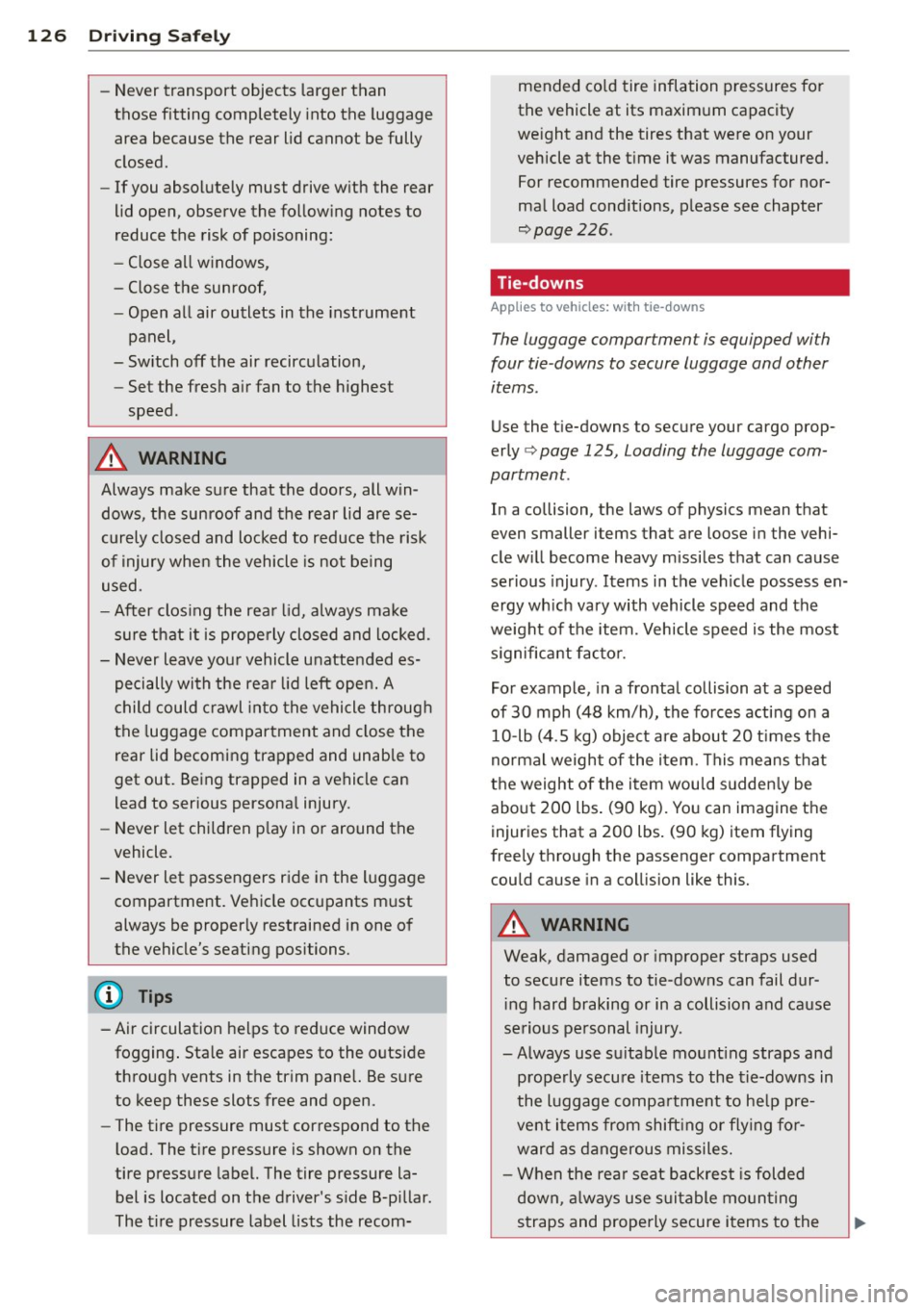
126 Driving Safely
-Never transport objects larger than
those fitting completely into the luggage
area because the rear lid cannot be fully
closed.
- If you absolutely must drive with the rear
lid open, observe the following notes to
reduce the risk of poisoning:
- Close all windows,
- Close the sunroof,
- Open all air outlets in the instrument
panel,
- Switch off the air recirculation,
- Set the fresh air fan to the highest
speed.
A WARNING
Always make sure that the doors, all win dows, the sunroof and the rear lid are se
curely closed and locked to reduce the risk
of injury when the vehicle is not being
used.
- After closing the rear lid, always make
sure that it is properly closed and locked.
- Never leave your vehicle unattended es
pecially with the rear lid left open. A
child could crawl into the vehicle through
the luggage compartment and close the
rear lid becoming trapped and unable to
get out. Being trapped in a vehicle can
lead to serious personal injury.
- Nev er let children play in or around the
vehicle.
- Never let passengers ride in the luggage
compartment. Vehicle occupants must
always be properly restrained in one of
the vehicle's seating positions.
@ Tips
- Air circulation helps to reduce window
fogging. Stale air escapes to the outside
through vents in the trim panel. Be sure
to keep these slots free and open.
- The tire pressure must correspond to the
load. The tire pressure is shown on the
tire pressure label. The tire pressure la
bel is located on the driver's side B-pillar.
The tire pressure label lists the recom-
-
mended cold tire inflation pressures for
the vehicle at its maximum capacity
weight and the tires that were on your
vehicle at the time it was manufactured.
For recommended tire pressures for nor
mal load conditions, please see chapter
r=>poge 226 .
. Tie-downs
App lies to veh icles : w ith tie -downs
The luggage comportment is equipped with
four tie-downs to secure luggage and other
items.
Use the t ie-downs to secure your cargo prop
erly
c> page 12 5, Loading the luggage com
portment.
In a collision, the laws of physics mean that
even smaller items that are loose in the vehi
cle will become heavy missiles that can cause
serious injury. Items in the vehicle possess en
ergy which vary with vehicle speed and the
weight of the item. Vehicle speed is the most
significant factor.
For example, in a frontal collision at a speed
of 30 mph (48 km/h), the forces acting on a 10-lb (4.5 kg) object are about 20 times the
normal weight of the item. This means that
the weight of the item would suddenly be about 200 lbs. (90 kg). You can imagine the
injuries that a 200 lbs. (90 kg) item flying
freely through the passenger compartment
could cause in a collision like this.
A WARNING
-Weak, damaged or improper straps used
to secure items to tie-downs can fail dur
ing hard braking or in a collision and cause
serious personal injury.
- Always use suitable mounting straps and properly secure items to the tie-downs in
the luggage compartment to help pre
vent items from shifting or flying for ward as dangerous missiles.
- When the rear seat backrest is folded
down, always use suitable mounting
straps and properly secure items to the
Page 184 of 286
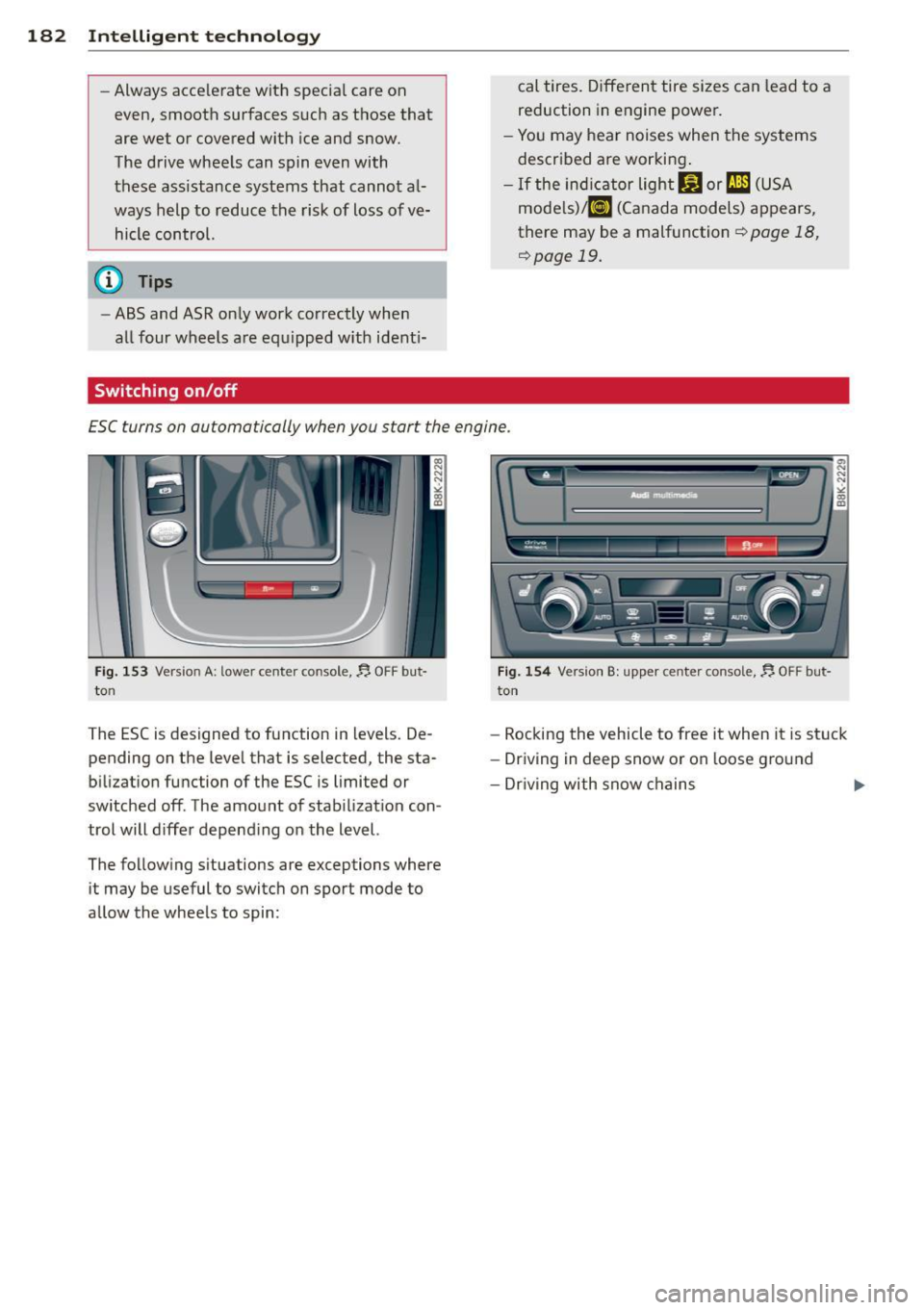
182 Intelligent technology
-Always accelerate with specia l care on
even, smooth surfaces s uch as those that
are wet or covered with ice and snow.
The drive whee ls can spin even with
these ass istance systems that canno t al
ways help to reduce the risk of loss of ve hicle control.
(i_) Tips
-ABS and ASR on ly wor k correctly when
all four wheels a re eq uipped w ith ident i-
Switching on/off
cal tires. Diffe ren t tire sizes can lead to a
reduction in engine power.
- Yo u may hear noises when the systems
descri bed are worki ng.
- If the in dicator ligh t
bl or t!lJ (USA
models)/ [IJ (Ca nada models) ap pears,
there may be a malfunction
¢page 18,
¢page 19.
ESC turns on automatically when you start the engine.
Fig . 15 3 Version A: lower center console,~ OFF but·
ton
The ESC is designed to function in levels . De
pending on the leve l that is selected, the sta
b ili zat io n function of the ESC is limited or
switched off. The amount of stabilizat ion con
trol will d iffe r depend ing on the level.
The following situations are exceptions where
it may be useful to switch on sport mode to
allow the whee ls to spin:
Fig. 154 Versio n B: uppe r ce nter console,~ OFF but·
to n
-Rocking the vehicle to free it when it is st uck
- Driving in deep snow or on loose g round
- Dr iving with snow c hains
Page 188 of 286
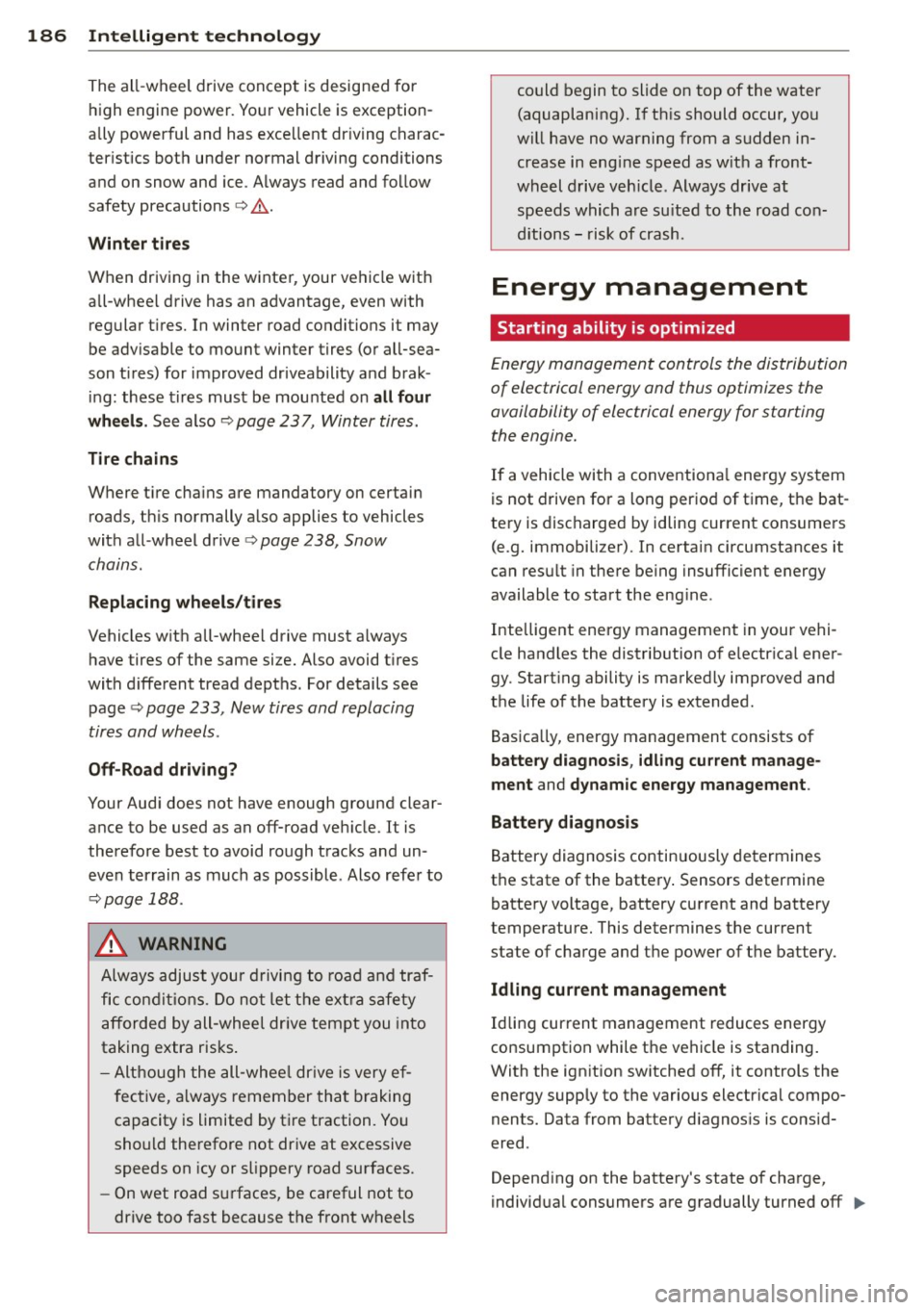
186 Intelligent technology
The all-wheel drive concept is designed fo r
high engine power. Yo ur vehicle is exception
ally powerful and has exce llent dr iving charac
te ristics both under normal driving conditions
and on snow and ice . Always read and follow
safety precautions
c:> ,&. .
Winter t ires
When driving in the winte r, your ve hic le with
a ll-whee l drive has an advantage, even with
regular t ires. In winter road conditions it may
be adv isable to mount winter tires (or all-sea
son t ires) for improved dr iveability a nd brak
ing: these t ires must be mounted on
all four
wheels . See also i=>page 237, Winter tires.
Tire chain s
Where tire cha ins are mandatory on certain
roads, th is normally a lso applies to vehicles
with a ll-wheel drive
c:> page 238, Snow
chains.
Replacing wheels /ti res
Vehicles w ith all -wheel drive must a lways
have tires o f the same size. Also avoid t ires
with d iffe rent tread depths . For details see
page
c:;> page 2 33, New tires and replacing
tires and wheels .
Off-Road driving?
Your Audi does not have enough ground clear
ance to be used as an off-road veh icle.
It is
therefore best to avoid rough t racks and un
even terrain as much as possible . Also refe r to
<=;> page 188.
A WARNING
Always adjus t you r d rivi ng to roa d and tr af
fic co ndition s. Do no t let the e xt ra s afety
a ff orde d by all -whee l dr ive tem pt you in to
taking extra risks .
- Alt hough the all-whee l dr ive is very e f
f ec tive, a lways remember tha t br aking
ca pacity is limited by t ire traction . Yo u
sho uld the refore not dr ive at excessive
speeds on icy or s lippery road surfaces.
- On wet road s urfaces, be careful not to
dr ive too fast because the front wheels co
uld begin to slide o n top of the water
(aquaplaning). If t his should occur, you
will have no warn ing fr om a s udden in
crease in eng ine speed as w ith a front
wh eel drive veh icle . Always dr ive at
speeds wh ich are su ited to the road co n
di tions -risk of crash.
Energy management
Starting ability is optimized
Energy management controls the distribution
of electrical energy and thus optimizes the
availability of electrical energy for starting the engine.
If a vehicle wi th a conventiona l ener gy sys tem
is not driven for a long per io d of time, the bat
te ry is discharged by idling current consumers
(e .g. immobilize r). In certain circumstances it
can res ult in there being insufficient energy
available to start the eng ine .
Intelligent energy management in your vehi
cle hand les the dist ribution o f electr ica l ener
gy. Start ing ability is markedly improved and
t h e life of the battery is extended .
Bas ica lly, energy management consists of
battery diagnosis , idling current manage
ment
and dynamic energy management .
Battery diagnosis
Battery diagnosis contin uously de termines
t h e state of the battery . Sensors determine
batte ry voltage, battery current and battery
temperature. This determines the current
state of charge and t he power of t he battery .
Idling current management
Idling current management reduces energy
consumption while t he vehi cle is standing.
With the ign ition sw itched off, it controls the
energy supply to the various electrica l compo
nen ts. Data from battery diagnos is is cons id
ered .
Depend ing on the battery's state of charge,
individ ual consumers are gradually turned off ..,.
Page 190 of 286
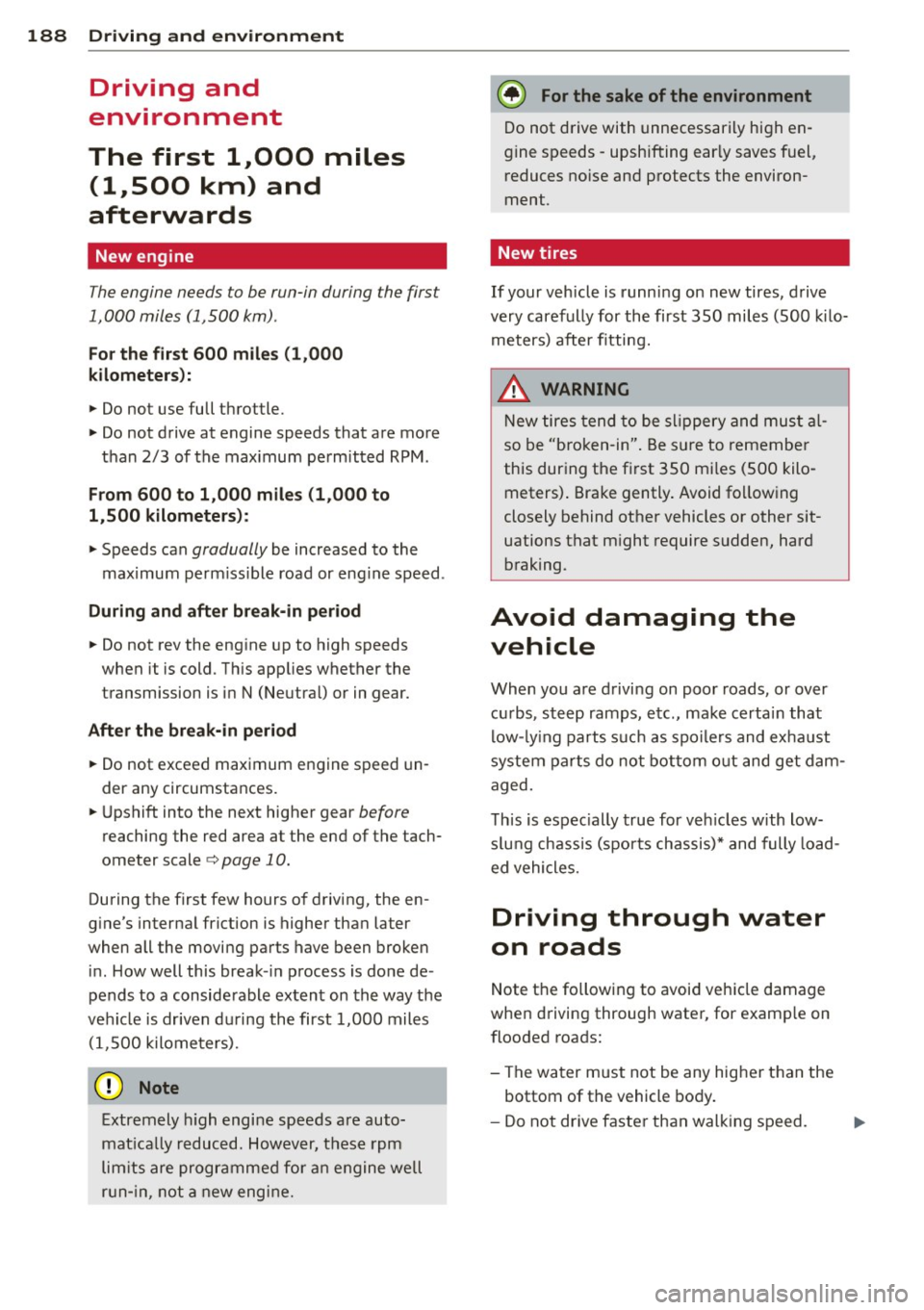
188 Driving and environment
Driving and
environment
The first 1,000 miles
(1,500 km) and
afterwards
New engine
The engine needs to be run-in during the first
1,000 miles (1,500 km).
For the fir st 600 miles (1,000
kilometers ):
.,. Do not use full throttle.
... Do not d rive at engine speeds that are more
than 2/3 of the max imum permitted RPM.
From 600 to 1,000 miles (1 ,000 to
1,500 kilometers):
.,. Speeds can gradually be increased to the
max imum pe rm iss ible road or eng ine speed .
During and after break-in period
... Do not rev the eng ine up to high speeds
when it is cold. Th is app lies whether the
transmission is in N (Neutra l) or in gear.
After the break- in period
... Do not exceed max imum engine speed un
der any circumstances .
... Upshift into the next higher gear before
reaching the red area at the end of the tach
ometer scale¢ page 10.
During the first few hours of driving, the en
g ine's inter na l friction is higher than later
when all the moving parts have been broken
i n. How well this break- in process is done de
pends to a conside rable extent on the way the
ve hicl e is driven du ring the first 1,000 miles
(1, 500 kilome ters).
(D Note
E xtremely high engi ne speeds are auto
mat ica lly r educ ed. However, t hese rpm
lim its are programme d for a n engine well
r u n- in, not a new eng ine.
{® For the sake of the environment
Do not d rive with unnecessarily high en
g ine speeds - upshifting ear ly saves fuel,
reduces no ise and protects the environ
ment.
, New tires
If your vehicle is runni ng on new tires, drive
very carefully for the first 350 miles (500 ki lo
meters) after fitting.
_& WARNING
N ew tires tend to be slip pery a nd mus t al
so be "b roken -in" . Be s ure to remembe r
this dur ing the fi rst 350 mi les ( 500 kilo
meters) . Brake gently . Avoid fo llow ing
closely behind other vehicles or other sit
uations that m ight require sudden, hard
braking.
Avoid damaging the
vehicle
When you a re d rivi ng on poo r roads, or over
cu rbs, ste ep ramps, etc., ma ke certai n that
low- ly ing parts s uch as spoile rs and ex ha ust
s ystem parts do not bot tom o ut and get dam
aged.
T his is espec ially true for veh icles with low
s lu ng chassis (s por ts chassis)* and fully load
ed vehicles.
Driving through water
on roads
Note th e following to avoi d ve hicle damage
whe n driving through water, for examp le on
flooded roads:
- The wa ter must not be any hig he r th an the
bottom of the vehicle bo dy.
- Do not dr ive faste r than wal king speed.
Page 196 of 286
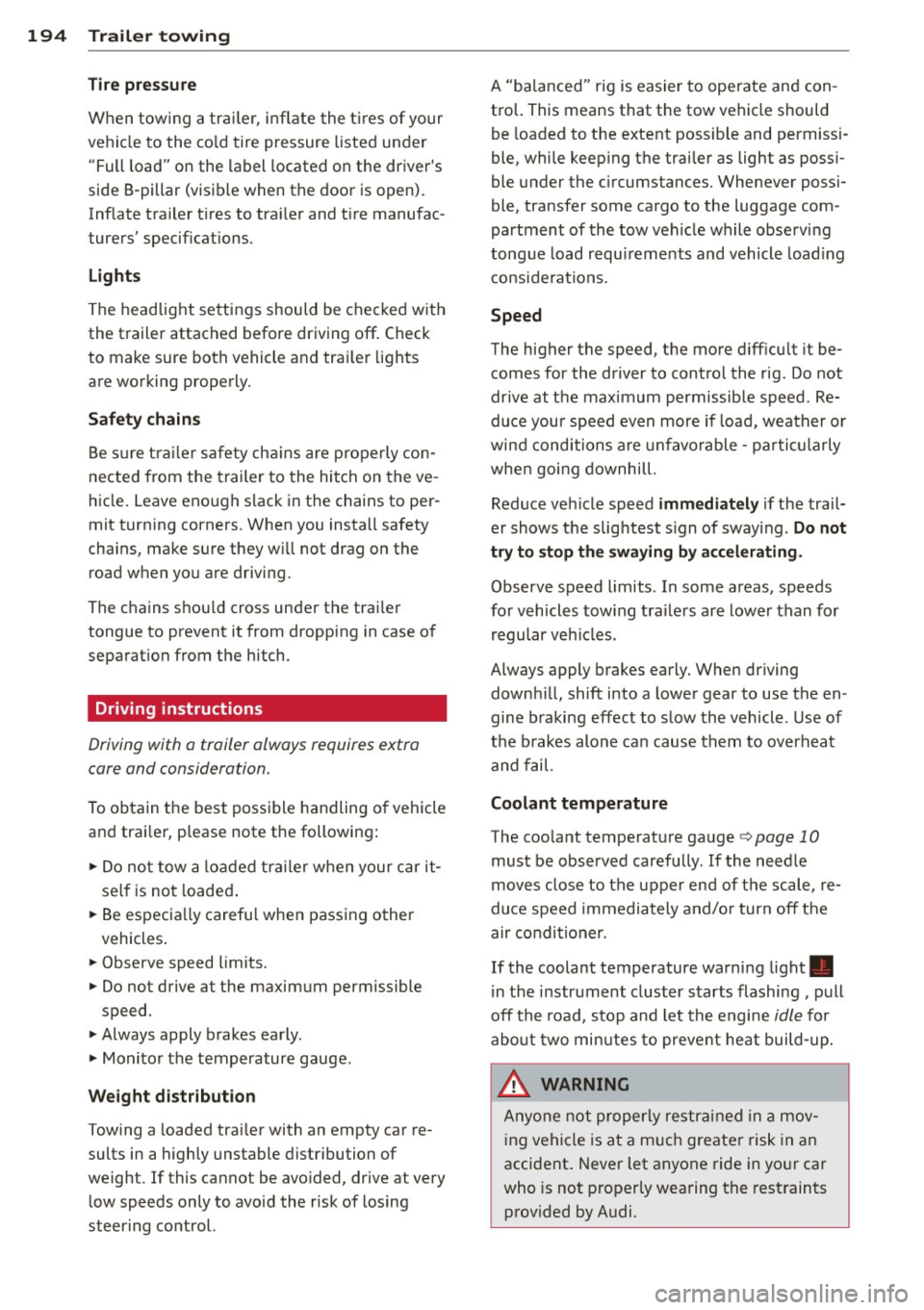
194 Trailer towing
Tire pre ss ure
When towing a trai le r, inflate the t ires of your
vehicle to the co ld tire pressure listed under
"Full load" on the label located on the driver 's
side B-pillar (visible when the door is open).
Inflate trailer tires to trailer and tire manufac
turers' specifications.
Light s
The headlight settings should be checked with
the trailer attached before dr iving off. Check
to make sure both vehicle and tra iler lights
are working properly.
Saf ety chains
Be sure tra iler sa fe ty cha ins a re p roperly con
nected from the trailer to the hitch on the ve
hicle. Leave eno ugh slack in the chains to per
mit turning corners. When you install safety
cha ins, make sure they w ill not drag on the
road when you are driving.
The chains shou ld cross under the trai ler
tongue to prevent it from dropping in case of
separation from the hitch.
Driving instructions
Driving with a trailer always requires extra
care and consideration.
To obtain the best possible handling o f vehicle
and trai ler, p lease note the following:
.,. Do no t tow a lo aded tra ile r when your car it
self is no t loaded .
.,. Be especia lly carefu l when passing other
vehicles .
.,. Observe speed lim its .
.,. Do not drive at the maximum permissible
speed.
.,. Always apply brakes early.
.,. Monitor the temperature gauge.
Weight di stribution
Towing a loaded trai ler with an empty car re
sults in a highly unstable distribution of
weight . If this cannot be avo ided, drive at very
low speeds only to avoid the risk of losing
steering control. A "ba
lanced" rig is easier to operate and con
tro l. This means that the tow vehicle should
be loaded to the extent possible and permissi
ble, while keep ing the trai ler as light as possi
ble under the c ircumstances. Whenever poss i
ble, transfer some ca rgo to the luggage com
partment of the tow veh icle while obse rv ing
tongue load requ irements and vehicle load ing
co nsiderations.
Speed
The higher the speed, the more d iff icu lt it be
comes for the driver to control the rig. Do not
drive at the maximum permissible speed. Re
duce your speed even more if load, weather or
wind conditions are unfavorable -pa rtic ularly
whe n goi ng downhill.
Reduce veh icle speed
imm ediately if the trail
er shows the slightest s ign of sway ing.
Do not
try t o sto p th e swaying by a ccelerating .
Observe speed limits . In some areas, speeds
fo r vehicles tow ing tra ile rs a re lower than for
regular veh icles .
Always apply brakes early. When driving downh ill, shift into a lower gear to use the en
gine braking effect to slow the vehicle . U se of
the b rakes alone can cause them to overheat
and fail.
Coolant tempe rature
The coo lant temperature gauge c> page 10
must be observed carefu lly. If the need le
moves close to the upper end of the scale, re
duce speed immediately and/or turn off the
air condi tioner.
If the coolant temperature warning light •
i n t he i nstrument cluster starts flashing, pull
off the road, stop and let the engine
idle for
abo ut two min utes to prevent heat build-up .
_& WARNING
Anyone not proper ly restra ined in a mov
i ng vehicle is a t a much greater risk in an
accident . Never let anyone ride in yo ur car
who is not p roper ly wea ring the rest raints
prov ided by A udi.
-
Page 224 of 286
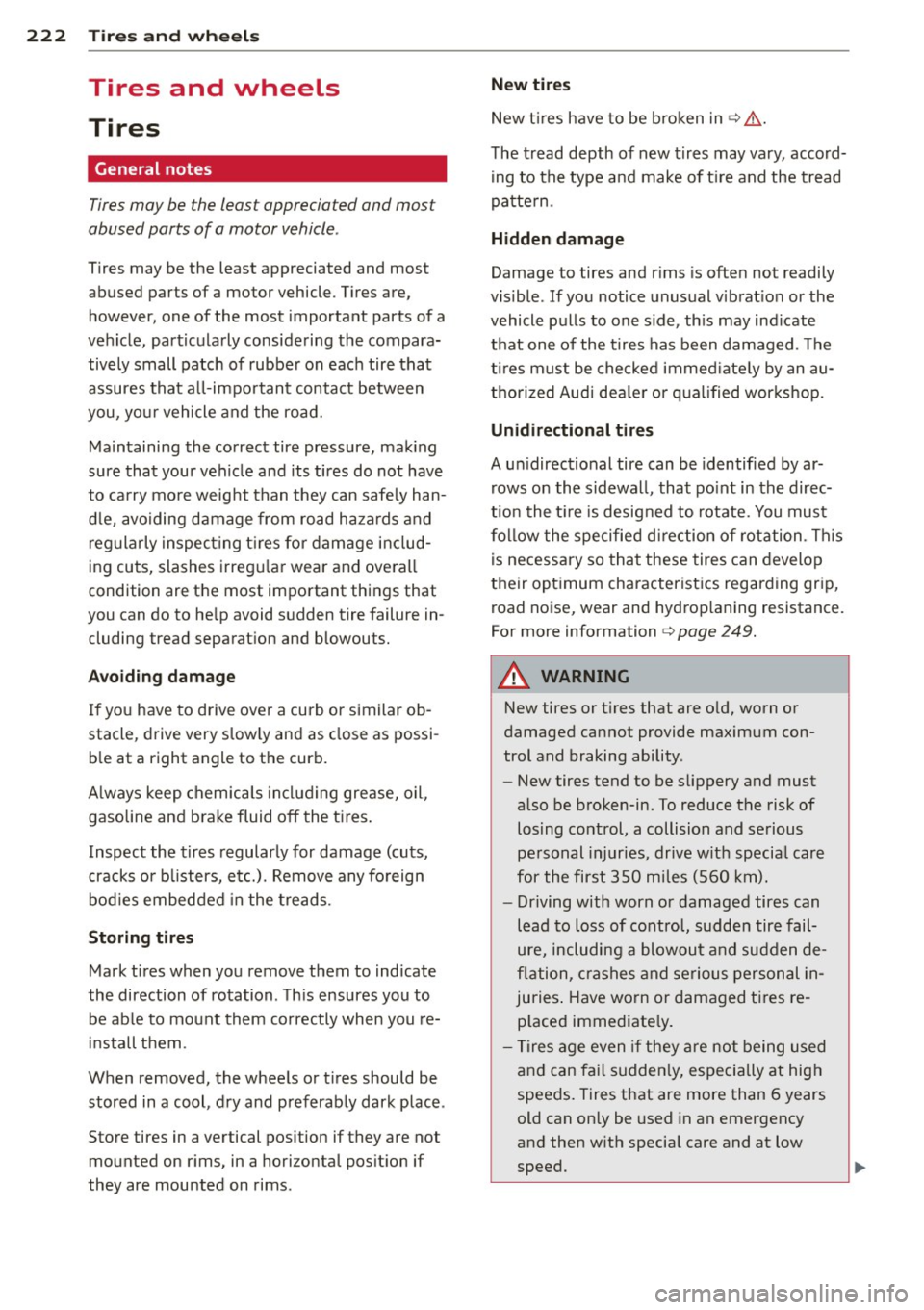
222 Tire s and wheel s
Tires and wheels
Tires
General notes
Tires may be the least appreciated and most
abused parts of a motor vehicle .
Tires may be the least appreciated and most
abused parts of a motor vehicle . Tires are,
however, one of the most important parts of a
vehicle, particularly considering the compara
tive ly small patch of rubber on each tire that
assures that a ll-impo rtant contact between
you, your vehicle and the road.
Maintaining the correct tire pressure, mak ing
sure that your vehicle and its tires do not have
to carry mo re weight than they can safe ly han
d le, avoiding damage from road hazards and
reg ularly inspecting t ires for damage includ
ing cuts, slashes irregu la r wear and ove rall
condition are the most important things that
you can do to he lp avoid sudden tire failure in
cluding tread separat ion and blowouts.
Avoiding damage I f you have to drive over a curb or similar ob
stacle, drive very s low ly and as close as possi
b le at a right angle to the curb.
A lways keep chem ica ls includ ing gre ase, o il,
gasoline and b rake fluid off the ti res .
Inspect the t ires regularly for damage (cuts,
cracks or b listers, etc.). Remove any fo reign
bod ies embedded in the treads.
Storing tires Mark tires when you remove them to indicate
the direction of rotation . Th is ensures you to
be ab le to mount them correctly when you re
install t hem.
When removed, the whee ls or t ires should be
stored in a cool, d ry and preferably dark place .
Store tires in a vertical pos ition if they are not
mounted on r ims, in a horizontal pos it ion if
they are mounted on rims. New tire
s
New t ires have to be broken in¢&,. .
T he tread depth of new t ires may vary, accord
ing to the type a nd make of t ire and the tread
pa tte rn .
Hidden damage
Damage to tires and r ims is ofte n not readily
vis ible . If you notice unusual v ibrat ion or the
vehicle p ulls to one s ide, th is may ind icate
t h at one of the t ires has been damaged . Th e
t ir es m ust be checked immed iate ly by an au
tho rized Aud i dea le r or q uali fied wor ks hop.
Unidirectional t ires
A un idirectional tire can be identified by ar
rows on the s id ewa ll, that po int in the direc
t ion the t ire is desig ned to rotate. You mus t
f ol low the specified d irection of rotation . This
is necessary so that these tires can develop
their optimum characterist ics regarding grip,
road no ise, wear and hyd rop laning resistance.
For more information
¢ page 249.
A WARNING
-New tires or tires that are o ld, worn or
damaged cannot provide maximum con
trol and braking ability .
-
-New tires tend to be slippery and must
also be broken-in. To reduce t he risk of
losing control, a collision and se rious
pe rsonal injuries, drive w it h specia l care
for the first 350 miles (560 km).
- Driving with worn or damaged tires can
le ad to loss of control, sudden tire fail
ure, including a blowou t and sudden de
fl ation, c rashes and seriou s personal in
juries . Have wo rn or damaged t ires re
p laced immediate ly .
- T ires age even if they are not being used
an d can fai l sudden ly, especially at high
speeds. Tires that are more than 6 years
old can only be used in an emergency
and then w ith specia l care and at low
speed.
Page 225 of 286
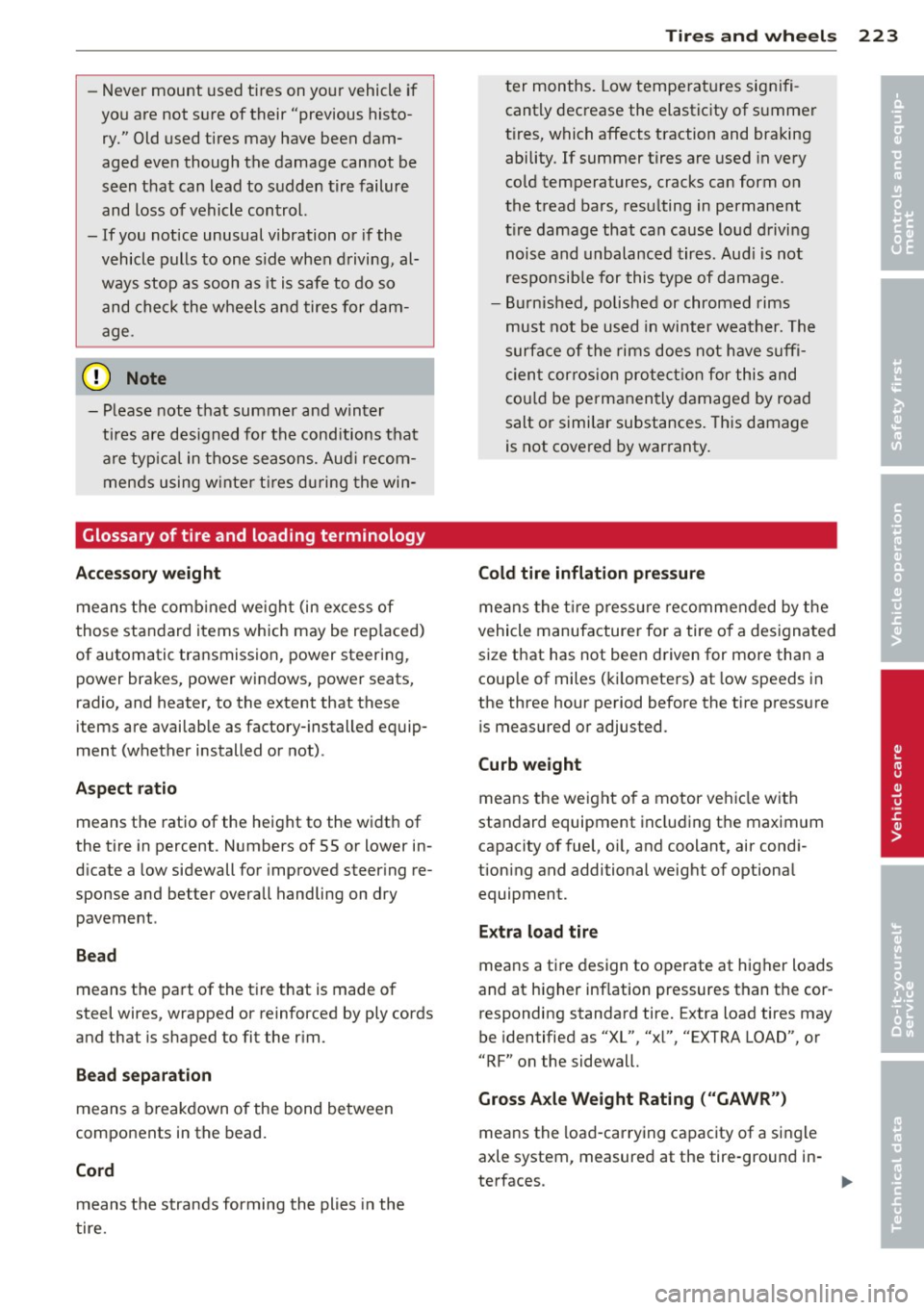
-Never mount used tires on yo ur vehicle if
yo u are not sure of their "previous histo
ry." Old used tires may have been dam
aged even though the damage cannot be
seen that can lead to sudden tire failure
and loss of vehicle control.
- If you notice unusual vibration or if the
vehicle pulls to one side when d riving, al
ways stop as soon as it is safe to do so
and check the wheels and tires for dam
age .
(D Note
-Please note that summer and winter
tires are designed for the cond itions that
are typ ic al in those seasons. Aud i recom
mends using w inter t ires du ring the win-
Glossary of tire and loading terminology
Accessory weight
means the comb ined weight (in excess of
those standard items which may be replaced)
of automatic tra nsmission, power steering,
power brakes, power windows, power seats,
radio, and heater, to the extent that these
items are availab le as factory-installed equip
ment (whether installed or not) .
Aspect ratio
means the ratio of the height to the width of
the tire in percent . Numbers of 55 or lower in
d icate a low sidewall for improved steering re
sponse and better overall handling on dry
pavement .
Bead
means the pa rt of the ti re that is made of
steel wires, wrapped or reinforced by ply cords
and that is shaped to fit the rim.
Bead s eparation
means a b reakdown of the bond between
components in the bead.
Cord
means the strands forming the plies in the
tire.
Tire s an d wheel s 223
ter months . Low temperatu res signifi
cantly decrease the elastic ity of summer
t ires, which affects traction and braking
ability. If summer tires are used in very
co ld temperatures, cracks can form on
the tread bars, res ulting in permanent
ti re damage that can cause loud drivi ng
noise and unbalanced tires. Aud i is not
responsib le for this type of damage.
- Burn ished, polished or chromed rims
must not be used in winter weather. Th e
surfa ce of the rims does not have suffi
c ien t cor rosion pro te cti on for this and
c o ul d be pe rmanen tly damaged by road
salt or similar substances. This damage
is not covered by warranty.
Cold tir e inflation pressure
me ans the t ire press ure re commended by the
vehicle manufacturer fo r a tire o f a des igna ted
size that has not bee n driven for more than a
couple of miles (k ilomete rs) at low speeds in
the three hour pe riod before the tire p ress ure
is measured or adjusted.
Curb weight
means the weight o f a motor vehicle with
standard equipment including the maximum
capacity of fuel, o il, and coolant, air cond i
tion ing and additional weight of optiona l
equipment.
E xtra load tire
means a tire design to operate at higher loads
and at higher inflation pressures than the cor
responding standard tire. Extra load tires may
be identified as "XL", "xl", "EXTRA LOAD", or
"RF" on the sidewall.
Gross Axle Weight Rating ("GAWR")
means the load-carrying capacity of a single
axle system, measured at the tire-ground in-
ter~ces .
~
•
•